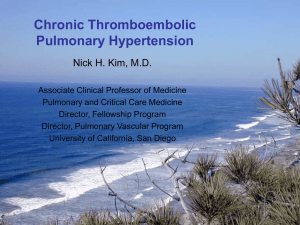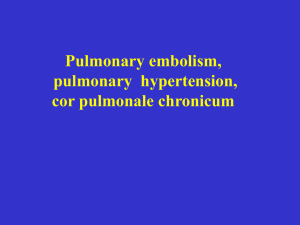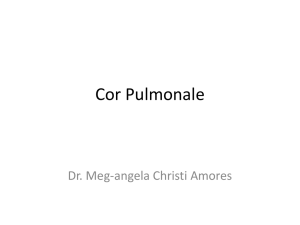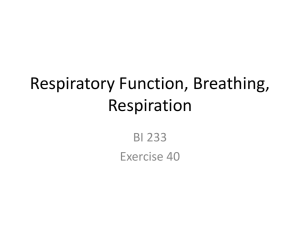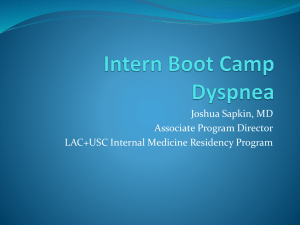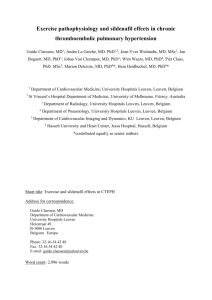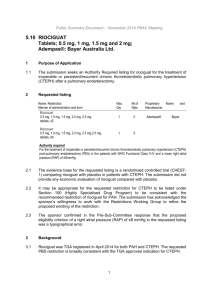PH Imaging Modalities CT Pulmonary Angiography
advertisement
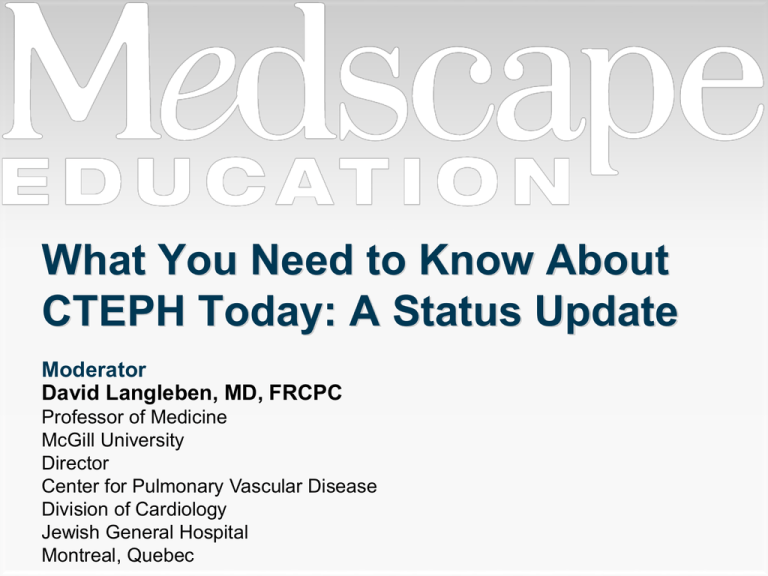
What You Need to Know About CTEPH Today: A Status Update Moderator David Langleben, MD, FRCPC Professor of Medicine McGill University Director Center for Pulmonary Vascular Disease Division of Cardiology Jewish General Hospital Montreal, Quebec Panelists Deepa Gopalan, MD, MSc, MRCP, FRCR Consultant Cardiovascular Radiologist Department of Radiology Papworth Hospital Cambridge, United Kingdom David Jenkins, MD, FRCS Director National Pulmonary Endarterectomy Program Consultant Cardiothoracic Surgeon Papworth Hospital Cambridge, United Kingdom CTEPH Pathophysiology • CTEPH develops from the obstruction of pulmonary arteries following episodes of PE with incomplete thrombus resolution, formation of fibrosis, and remodeling of pulmonary blood vessels. • Consequently, PVR is increased, leading to PH and progressive right heart failure. Jenkins D, et al.[1] Dartevelle P, et al.[2] CTEPH Underdiagnosed and Treatable • CTEPH is more common than people realize. − It is hard for general physicians to make the diagnosis because many of the symptoms are nonspecific, such as fatigue and breathlessness on exertion. • It is one of the most treatable forms of PH. − There is a curative treatment available in the form of PEA. Jenkins D, et al.[1] Pulmonary Hypertension Classification Group 1 Group 2 Group 3 Group 4 Group 5 Simonneau G, et al.[7] Pulmonary arterial hypertension PH owing to left heart disease PH owing to lung diseases and/or hypoxia CTEPH PH with unclear or multifactorial etiologies CTEPH Incidence • Earlier estimates suggested that < 1% of people would develop CTEPH following an acute PE. • Some of the more recent studies report: − 1%a − 3.8%b − 8.8%c a. Becattini C, et al.[4] b. Pengo V, et al.[3] c. Dentali F, et al.[5] CTEPH Risk Factors • CTEPH should be considered in all patients with unexplained PH. • Other risk factors include: − Ventriculo-atrial shunt − Indwelling catheters and leads (such as chronic dialysis catheters and pacemakers or automated implantable cardiac defibrillator leads) − Splenectomy − Thyroid replacement therapy − Inflammatory bowel disease − History of malignancy Jenkins D, et al.[1] Patients With Untreated CTEPH Survival and PPA Green dotted line represents predicted survival among men 40-50 years old. Riedel M, et al.[13] CTEPH Diagnosis • Chest radiography and echo are used in the initial assessment of suspected PH. − PH is defined by a mean PPA > 25 mm mercury. • The key thing is, within the population diagnosed with PH, not to miss any patients with CTEPH. − One of the problems is that some of the signs on imaging are relatively subtle and can be easily missed. That is why if you suspect it, get an expert’s advice. Jenkins D, et al.[1] Pulmonary Hypertension Imaging Algorithm McCann C, et al.[14] PH Imaging Modalities V/Q scan Thromboembolic Disease Courtesy of Dr Gopalan. IPAH PH Imaging Modalities CT Pulmonary Angiography Courtesy of Dr Gopalan. CT Pulmonary Angiography Acute vs Chronic PE Courtesy of Dr Gopalan. CT Pulmonary Angiography Proximal vs Distal CTEPH Courtesy of Dr Gopalan. PH Imaging Modalities Catheter Pulmonary Angiography Courtesy of Dr Gopalan. PH Imaging Modalities Cardiac MRI McCann C, et al.[14] Conditions That Mimic CTEPH Pulmonary Artery Sarcoma Courtesy of Mr Jenkins. CTEPH Patient Evaluation for PEA • It is important to give every patient a chance at operability because it makes such a huge difference for them. − PEA is the only approved and potentially curative treatment currently available. • The experience of the PEA team determines which lesions are considered surgically treatable. − High PH, PVR, and very low cardiac output are associated with increased perioperative risk. − Proximal occlusive webs in the lower lobes and a positive history of PE that is relatively short are associated with good results from surgery. Jenkins D, et al.[1] Dartevelle P, et al.[2] Auger WR, et al.[6] Pulmonary Endarterectomy Current Mortality Rates • In experienced centers around the world, current mortality rates are quite low, approaching that of conventional cardiac surgery. • Some of the more recent studies report: − 2.2%a − 4.7%b − 1.4%c a. Madani MM, et al.[21] b. Mayer E, et al.[22] c. Vuylsteke A, et al.[23] Pulmonary Endarterectomy Difficulties to Overcome • • • • Central location PA 5-L/min blood flow Thin-walled vessel Dual circulation Courtesy of Mr Jenkins. Pulmonary Endarterectomy Technique Overview • Median sternotomy incision, for approach to both lungs • Cardiopulmonary bypass, with cooling to 20o C (circulatory arrest for 20 minutes) • Clearance of PA obstruction to reduce PVR • Full distal dissection to every segmental vessel Courtesy of Mr Jenkins. Pulmonary Endarterectomy Verbal Recognition Memory Immediate Test (% of Patients Who Scored 24) Perioperative Cognitive Function Vuylsteke A, et al.[23] Pulmonary Endarterectomy Conditional Survival Freed DH, et al.[24] Pulmonary Hypertension Potential for Targeted Drug Therapy Although PEA is potentially curative, medical therapy is needed in patients with inoperable disease or persistent/recurrent PH. Sitbon O, et al.[25] Bosentan BENEFiT Trial Trial Design • Inoperable CTEPH or persistent pulmonary PH after PEA • N = 157, randomized to placebo or bosentan • Treatment duration = 16 weeks Results • PVR mean treatment effect: -24.1%, P = .0001 • 6-minute walk distance mean treatment effect: 2.2 meters Jaïs X, et al.[26] Riociguat CHEST-1 Trial Trial Design • Inoperable CTEPH or persistent pulmonary PH after PEA • N = 261, randomized in a 2:1 ratio to riociguat (≤ 2.5 mg 3x daily) or placebo • Treatment duration = 8 weeks titration + 8 weeks maintenance Results • Primary end point, 6-minute walk distance: 46-meter improvement compared with placebo (P <.0001) • Significant improvement in most secondary end points, including PVR, NT-proBNP, and WHO functional class change compared with placebo Ghofrani H, et al.[27] CTEPH Summary • CTEPH is a disease recognized with increased frequency through radiologic detection with a variety of imaging techniques. • Pulmonary endarterectomy, the treatment of choice, is potentially curative and associated with a reasonably low risk. • Drug therapies for the remaining patients who are not surgically approachable are being developed. Thank you for participating in this activity. To proceed to the online CME test, click on the Earn CME Credit link on this page.
